The cutting edge (a resilient plant procurement strategy supporting HS2’s Green Corridor)
High Speed Two (HS2) is a catalyst for growth across the UK. Along with this comes not just environmentally responsible landscape and ecological design but, offers a once in a generation opportunity to secure a green corridor that fuses the railway with its contextual landscape. Central to delivering this is HS2’s Plant Procurement Strategy.
This paper captures how the Plant Procurement Strategy was conceived and developed in collaboration with stakeholders. It sets out the Plant Procurement Strategy’s primary purpose, application and its centrality to fulfilling HS2’s environmental commitments across the project’s one-hundred-and-twenty-year design life.
An insight is also provided into the uniqueness of the strategy amongst mega-infrastructure projects in terms of its scale and vision and its innovative, sustainable and resilience planning credentials as core guidance for decision makers, designers and project managers in procuring, planning, designing and delivering up to 7 million trees. The Plant Procurement Strategy also supports HS2’s Green Corridor project with its two parallel goals, to minimise and compensate for the environmental impact of HS2 and, to support neighbouring communities to further improve the local environment alongside the railway.
This paper reveals how the strategy sets the framework designers can follow to fully mitigate the landscape character and visual effects Environmental Minimum Requirements contained in the HS2 Environmental Statement as well as how it will inform integrated landscape design solutions, planting typologies and species selection. These collective requirements consistently applied by different contractors across the Phase 1 route will establish a legacy railway landscape.
Tree and shrub stock will be required at various times in the overall construction programme from early landscape and ecological mitigation planting through main construction works to the end of the construction programme. The paper provides a unique insight into such challenges and solutions of procuring this volume of living material as trees and shrubs and the inherent complexity due to a combination of legal, programme , biosecurity, quality, and environmental considerations.
Also explored are lessons learned outlining the importance of effective project programming that considers the seasonal nature of planting, the criticality of soil resources as well as innovation using innovative technologies around the whole life management of data. The reader will see how supplying plants of the right provenance, at the right time of the right quality to their intended location along the one hundred- and thirty-five-mile route of HS2 Phase 1 required a strategy with a degree of built-in pragmatic flexibility to take account of the many vagaries of large-scale construction such as logistics, weather conditions and programme changes.
The HS2 Plant Procurement Strategy can be considered a whole life project guide to aid design and delivery, to help plan a future, well designed, resilient landscape infrastructure, one that conserves, enhances, restores, and transforms all the various locations and different scales of landscape the railway encounters.
Background
The poet Sir John Betjeman, a devotee of railways, often wrote of the inseparable relationship between railways and the landscape, nowhere better expressed when he said that ‘the railways carve out a landscape of their own,’ although not always with sensitivity to that landscape.
Today when people hear of HS2 in the news it is likely they immediately conjure an image of the train and its track in their minds eye. Less visible to most people is the extensive landscape either side of the 140-mile route of Phase One that has been committed to as part of this mega-project for the UK.
The expertise of Landscape Architects (seen working on site in the image below) as part of a multi-disciplinary design team is required to both integrate the railway infrastructure into its physical surroundings and respond, as a good neighbour, to local communities. Trees and shrubs, grasslands and new wildlife habitats are essential components of this emerging HS2 landscape. HS2 has already started planting new woodlands and creating new ponds, grasslands and meadows, with many new habitats flourishing, before a single train has started running. In total, HS2 will leave behind more than 33 square kilometres of new woodland, wildlife and river habitats from the West Midlands to London, the equivalent of 23 new Hyde Parks. To deliver this HS2 have established the Green Corridor project with two parallel goals: to minimise and compensate for the environmental impact of HS2 and to support our neighbours to improve the local environment. Much of this green infrastructure will not have reached full maturity until many years after HS2 first carries passengers. This green legacy on a vast scale will benefit future generations through sequestering of carbon, establishment of wildlife corridors links between habitats and through inbuilt resilience to future climate change. Defining the right approach to the procurement of trees and shrubs was therefore essential.
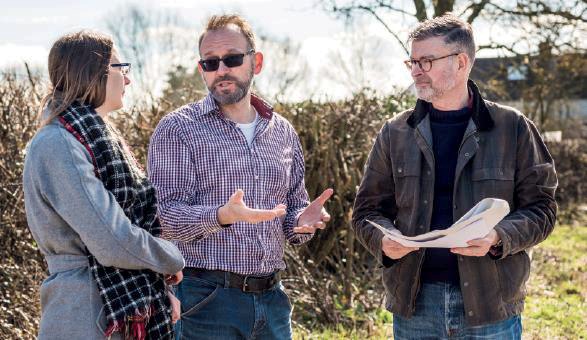
A distinguishing feature of HS2 from other linear, transport infrastructure projects is that for Phase One only one percent of the railway is what’s called ‘at-grade’ that is, level with theexisting ground. For ninety nine percent of the route the railway is either in an earthworks cutting, on an earthworks embankment or crossing a viaduct. In response to this creating a continuous green corridor is vital to integrating the ‘grey’ infrastructure into the local landscape character which alters constantly.
To create a living, green corridor over a ten-year construction programme demanded a robust Plant Procurement Strategy and supply of plants. Planting for this mega-project delivers a wide range of functions including planting for visual screening; planting to blend the scheme into the landscape; reinstatement of agricultural land; connecting to existing planting; enhancement of biodiversity; wildlife corridors and even new landmarks. To communicate potential design resolutions to these multi-functional, multi layered challenges and to inform future design teams and stakeholders the HS2 Landscape Design Approach1 was developed.
Sitting alongside the Landscape Design Approach are a suite of HS2 technical landscape standards. The Plant Procurement Strategy is one of the most vital since it guides the delivery of the landscape infrastructure for the whole life of HS2. Figure 2 shows in blue the extent of landscape treatment either side of the railway at Water Orton in the Midlands. The strategy also guides how the landscape mitigation and commitments in the HS2 Phase 1 Hybrid Bill Environmental Statement can help be fulfilled. At the same time the Plant Procurement Strategy supports HS2’s environmental policy objectives, those of responsible consumption, sustainability, climate change, and importantly the creation of HS2’s Green Corridor Project.
Making optimal early-stage design decisions determine how well the landscape establishes and matures. The HS2 Plant Procurement Strategy provides the framework for that decision making. It signposts to an ‘endstate’ that supports fulfilment of environmental obligations and optimum project benefits. The following section explores key sections of this guidance framework.
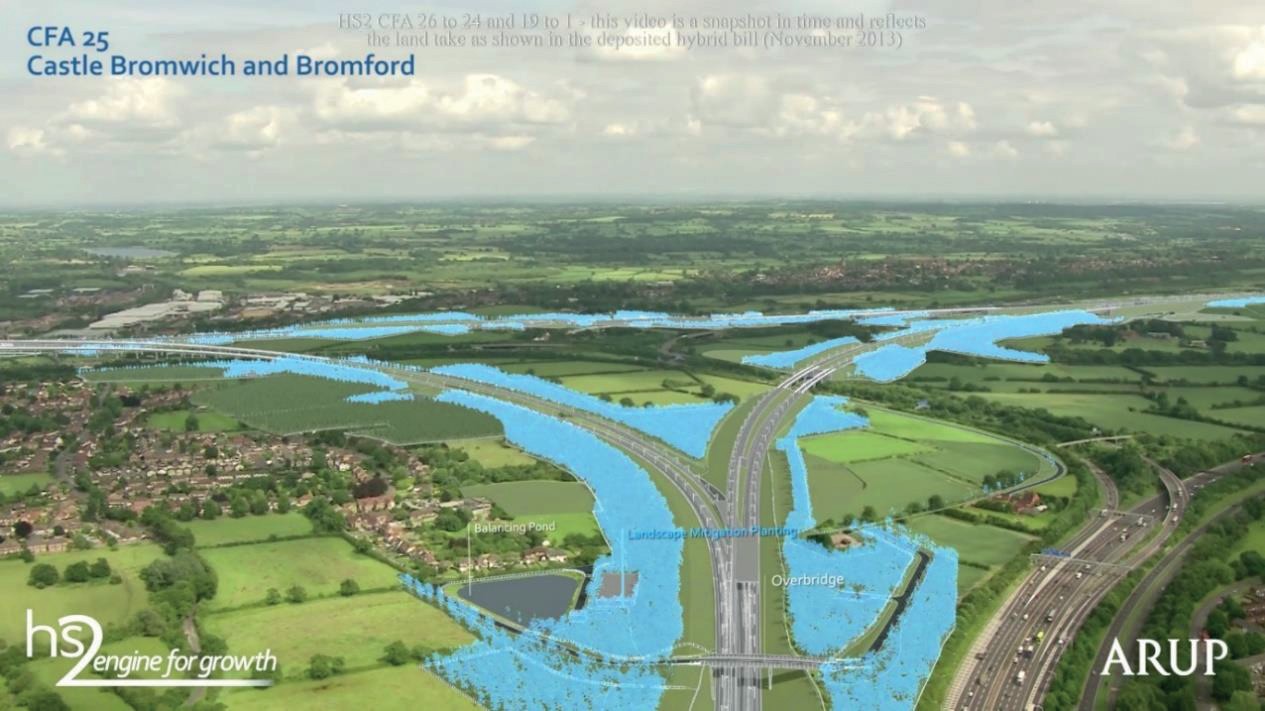
Approach
One early step taken so that the Plant Procurement Strategy and the plant procurement began their travel in the right direction was to establish a collaboration forum. The HS2 Tree Working Group comprised HS2 topic experts alongside representatives from the Woodland Trust, National Trust, Chartered Foresters, The Land Trust, Forestry Commission (FC), Canal and River Trust, The Tree Council, Horticultural Trades Association, BALI and The Confederation of Forest Industries. The Group’s collective aims were to: share and gather current best practice on procurement of large volumes of plant material; how best to approach large scale contract planting; current biosecurity guidance; plan for seed / plant provenance; to better understand the wider horticultural and forestry plant material industry and to consider any ways the HS2 supply of plant material contract might affect the wider industry.
Importance of provenance and resilience planning
The importance of the provenance of tree plant seed (its genetic place of origin) was one innovative aspect of the Plant Procurement Strategy drawing on specialist advice from the Forestry Commission and Tree Working Group.
The increased movement of people and plants around the globe and the warmer, wetter weather brought about by climate change makes it inevitable that Britain’s trees will continue to be threatened by pests and diseases. Forestry Commission research suggests it is also increasingly likely that the tree cover of the UK will be a much more rapidly changing one in the future. This threat to poor establishment of mass planting over many years and protecting investment of public money could not be overlooked.
The Plant Procurement Strategy contains a clear directive that all woodland planting and its management will be compliant with requirements and guidelines of The UK Forest Standard (UKFS). Species selection will also take account of tree and shrub species for a changing climate using latest research from the FC. This standard recommends that most tree planting shall be from local species – those of local genetic provenance and that they are UK grown. The FC maintains the National Register of Approved Basic Material for Great Britain. This is published in accordance with the Forest Reproductive Material (Great Britain) Regulations 2002 and European Union directive 1999/105/EC, which controls the marketing of Forest Reproductive Material (cones, fruits, seeds, all parts of plants obtained by vegetative propagation) in the European Union. It stipulates that all stock shall be grown in the UK and despatched following industry advice. This is to minimise any risk of disease transfer from continental and aligned with the UK Government’s ‘Grown in Britain’ initiative.
The definition of cones, fruits, seeds that have local or regional provenance used to grow plant stock requires some elaboration.
Great Britain is divided into four regions of provenance. These are defined areas within which similar ecological and climatic characteristics are found. They provide a framework for specifying sources of Forest Reproductive Material (FRM). The route of HS2 Phase 1 depicted as a red line in the map below (see Figure 3) passes through Region of Provenance 40. The title of the map ‘Assisted migration of native trees’ refers to the principle where species native to the UK have, since the last ice-age, migrated northwards from northern continental Europe. This migratory response in trees is likely to be accelerated by climate change.
Research by Forest Research (FR) the research agency of the Forestry Commission (FC) shows that tree stock grown from seed of the regional provenance in northern France (-2 degrees latitude) will have naturally heightened resilience to higher temperatures and drought conditions.
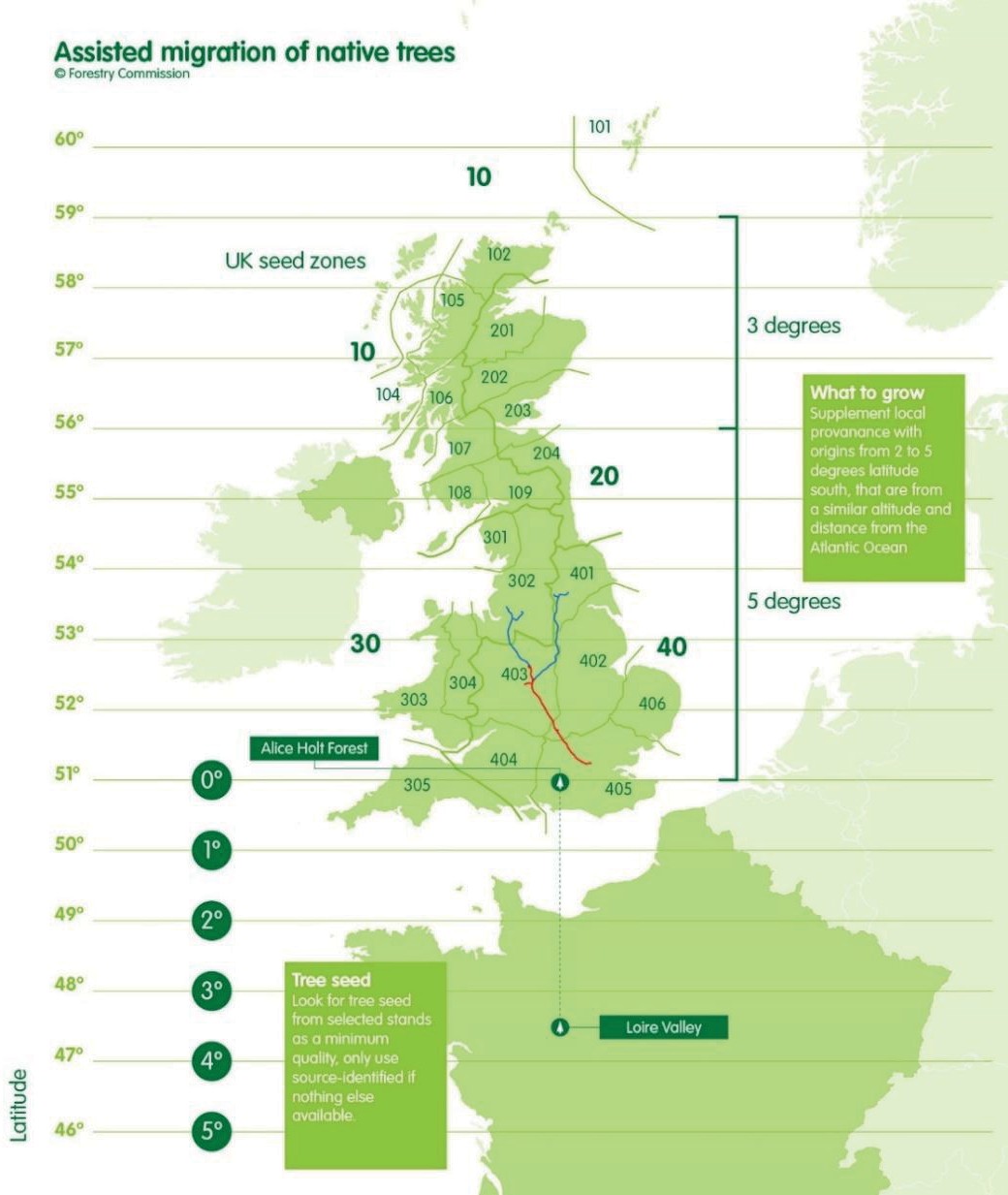
To optimise resilience to future climate change and provide plant material that has adaptability to changing conditions the Plant Procurement Strategy sets out following recommendations that guide all seed and plant procurement and planting design:
- natural regeneration is encouraged as a first option
- Seed collection ensure collection is from a wide number of seed trees for a broad genetic base.
- 1/3 of seed from same region of provenance should make up the planting stock.
- 1/3 of seed from source up to 2º south of the growing site should make up the planting stock.
- 1/3 of seed from slightly warmer climate sources from 2 to 5° of latitude further south than the site should make up the planting stock.
Such a strategy supports the maximum survival rate, reduced re-planting costs and minimises the risk of planting areas not meeting their mitigation objective.
The recommended percentages are based on what can be practically achieved in terms of seed collection and volume and viability of seed for regional provenance stock for the project.
Research confirms that by adopting this targeted but wide genetic base also contributes to specified plant stock being healthy and resistant to pests and disease. For biosecurity, all suppliers will be required to sign up to specific controls on the planting and importation of seeds, and plant stock shall have traceable records of all provenance independently verified. The Plant Procurement Strategy stipulates that planting schemes shall avoid specifying large numbers of a limited range of tree species, to minimise the spread and effect of disease.
To ensure consistent, high-quality products all plant species, sizes and root condition are to be specified in accordance with the Horticultural Trade Association (HTA) National Plant Specification (HTA 2002).
Species selection and landscape character
Planting groups or typologies and individual plant species selection is based on a scale that matches that of HS2’s infrastructure. Plant selection shall be contextually responsive to local character whilst also acknowledging, at appropriate scales, the existing national, regional and local planting strategies including any plant species information captured in HS2’s Landscape Character Areas defined in the Environmental Statement.
Landscape Architects designing the advanced planting packages innovated by mapping the route as it passed through fourteen of Natural England’s National Character Areas (NCA). Using these NCA’s, design teams overlaid data from the National Forestry and Ancient Woodland inventories, along with Forestry Commission native seed zones to provide a basis for the selection of native tree and hedgerow planting mixes to be included in the planting mitigation typologies.
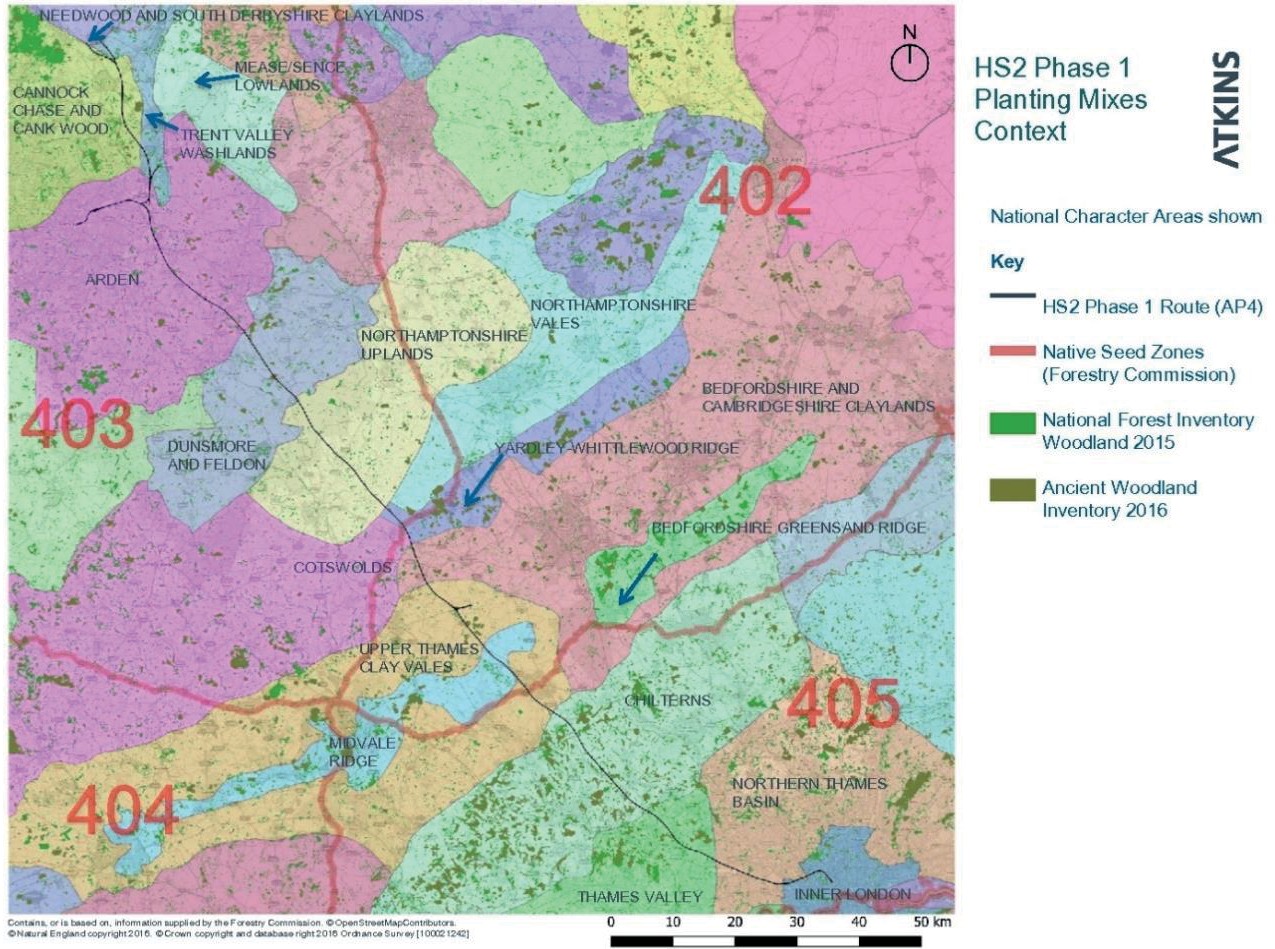
The planting design was locally responsive to the changing palette of woodland types, hedgerows and wildlife habitats combining species mixes that are locally responsive to the changing geology, soils, seed zones and landscape character alongside the railway from London to Birmingham.
This process identified some notable target species where seed of local provenance would need to be gathered and propagated for example the rare Black Poplar Populus nigra that has protection under the Countryside and Wildlife Act, 1981 and Midland Hawthorn Crataegus laevigata.
Planting typologies / plant numbers
The Environmental Statement for Phase One and the conceptual landscape design ‘Proposed Scheme’ drawings work prepared for the Hybrid Bill defined the types of landscape mitigation planting needed to address landscape and visual effects. This multi- functionality of landscape planting is referred to in the Landscape Design Approach but more specifically in the Plant Procurement Strategy. The latter contains a list of planting typologies established to inform the design of planting for the duration of the Project. It also links design and planting typologies with the specific requirements for procurement and programming plant material supply and planting. Seven high -level planting typologies were identified:
- Woodland habitat planting
- Ancient woodland soils translocation and new native woodland planting
- Landscape planting
- Screen planting
- Hedgerow habitat planting
- Feature planting (within rural areas)
- Feature planting (within urban areas / public realm)
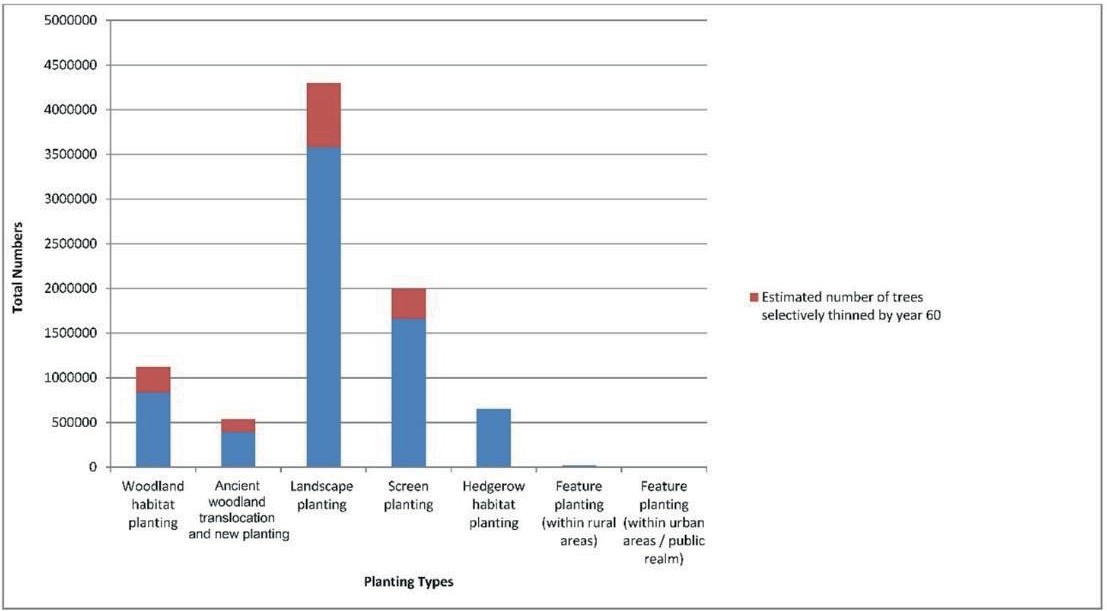
Phase One of HS2 involves planting some 650 ha of woodland comprising landscape / ecological mitigation. Ahead of any contracts being awarded there needed to be an estimate of the likely number of plants that would be required to establish this area mitigation planting to fulfil the HS2 Phase 1 Hybrid Bill Environmental Minimum Requirements. The estimates for numbers of plants required was generated from the seven planting typologies using the Hybrid Bill ‘Proposed Scheme’ drawings. The early estimates for each typology are shown in Figure 5 above.
The subsequent approach to plant procurement relied not only on these plant number estimates but information from landscape scheme designs in response to landscape character and visual assessment in the Hybrid Bill – Environmental Statement, Stage 1 ecology survey data and best practice industry guidance.
It was the whole life cycle landscape design thinking, contained in the Plant Procurement Strategy, that informed the framework for procuring the supply of plant material contract by applying the planting typologies to the design of specific mitigation sites to generate plant numbers and species mixes.
Woodland Habitat Planting – this typology aims to maximise the use of native species characteristic and appropriate to the mitigation site. The strategy recommends planting is programmed as early as reasonably practicable within the project programme. Woodland habitat areas shall be planted with different mixes of tree species and include features such as rides and glades to help maintain the identity of adjacent retained woodlands. These features are part of the early design process but they are realised through the maintenance regime.
Ancient woodland – the Plant Procurement Strategy recognises that ancient woodland cannot be recreated and is recognised as irreplaceable within the timeframe of the Project. To recompense for loss of ancient woodlands one or more of the following measures shall be implemented at each ancient woodland site, as appropriate:
- soil translocation (to utilise seed banks present in the ancient woodland soil)
- translocation of coppice stools, and other small trees; and/or
- translocation of fallen or standing deadwood.
Where ancient woodland soil is translocated (containing valuable seed bank) to pre- prepared ecological compensation sites the soil placement areas can be planted with a mix of broad-leaved trees to increase the extent of existing woodland and the connectivity of planting within the wider landscape. The Plant Procurement Strategy stipulates that all native planting to soil placement areas shall comprise:
- 2/3 of plant stock from the same region of provenance and,
- 1/3 of plant stock from regions up to 2 ° latitude south.
Flexibility was built into the strategy for translocated ancient woodland soils so that at the detailed design stage the proportion of stock from 2+ ° latitude south could be increased if appropriate for specific sites. Species characteristic and appropriate to the original ancient woodland area shall be selected. Figure 6 below shows this sequence of ancient woodland soils translocation. From left to right: year 1 planting; maturation of nurse crop & thinning of saplings to early maturity and creation of glades ten years later. Site monitoring is planned to extend from year 1 to beyond twenty years.
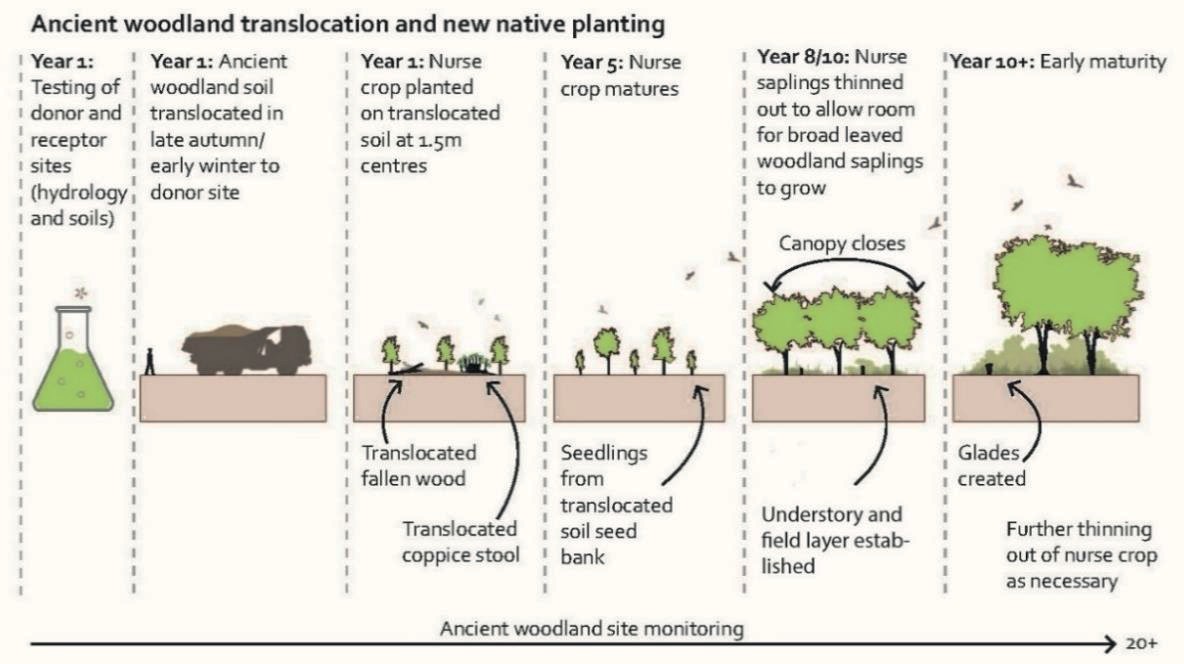
Screen planting – this planting typology derives from the visual effects section of the HS2 Environmental Statement. The planting is designed to obscure and filter views of HS2 from sensitive visual receptors. Screen planting can also reduce the visual prominence and help integrate structures into the local landscape including viaducts, bridges, tunnel portals and retaining structures. Additional winter screening can be achieved through an increase in the percentage of evergreen species in planting mixes that might include holly, privet, yew and Scots pine.
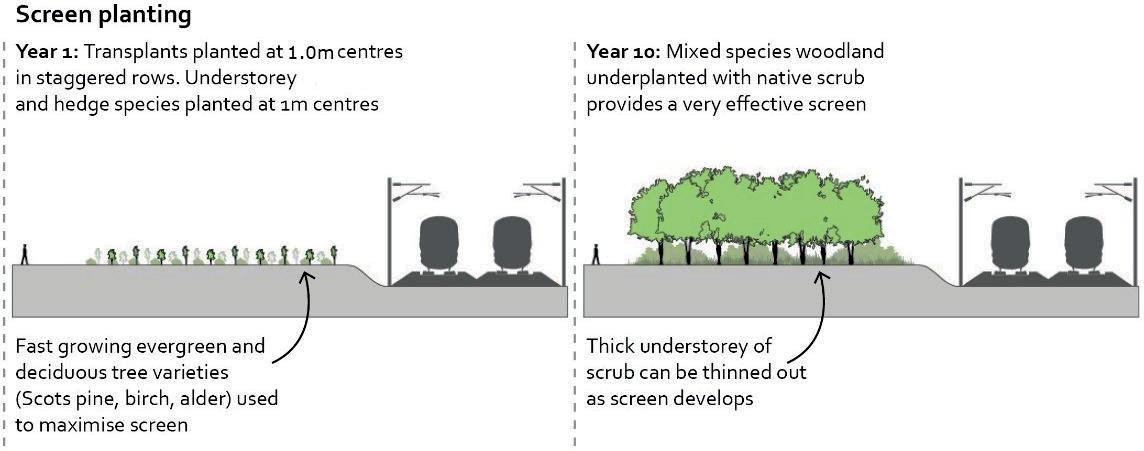
Screen planting is likely to be planted at a higher density than new woodlands and designers can introduce irregular staggered rows to improve the screening effect. Akin to other planting types in some locations sacrificial, fast-growing species can be designed to provide rapid screening benefits. These species are thinned out and removed as the slower growing dominant woodland species, more in keeping with the character of the local landscape, mature. Figure 7. shows an indicative time sequence and design principles for effective screen planting.
Hedgerow planting – is one of the most important planting typologies along the route since it compensates for the fragmentation of the existing hedgerow network, a characteristic typical to many swathes of the English countryside, in addition to creation of entirely new hedgerows and the enhancement/ thickening of existing features. Aligned with the strategy for other plant typologies hedgerow planting should be tailored to match species found in the surrounding area and matching ecology survey data. This use of native species of local provenance is the golden thread running through the HS2 planting procurement strategy.
Soil management
The strategy also emphasises that soils are a valuable asset. Handling them to best practice standards is vitally important to a project of this scale. Soil is a vulnerable and non- renewable resource and is central to sustainability. Some of the most significant adverse impacts that can occur on soils result from construction activities, often because of a lack of awareness and understanding on the part of the contractors. Figure 8 highlights the importance of working at scale; from strategic to the very detailed.
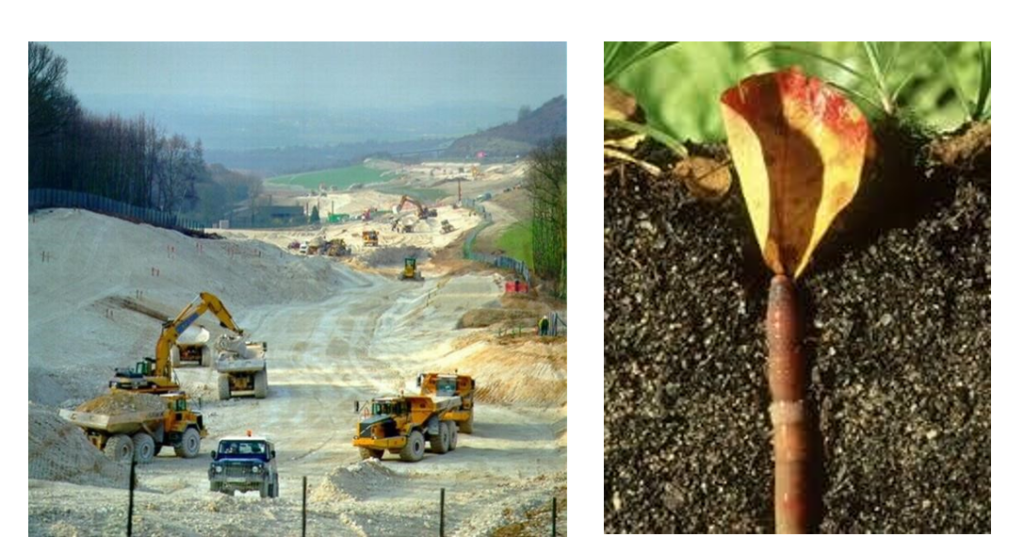
During the advance works and prior to the start of any earthwork operations soil surveys undertaken by a suitably qualified soil scientist are required. The data from these surveys will be incorporated into the Project Construction, Demolition and Excavation Waste (CDEW) Strategy and Materials Management Plans.
Critical in preserving soils and to support the establishment of all mitigation planting and seeding these two plans shall clearly define: soil types; areas of soil to be stripped; haul routes and stockpile locations. Contractors must provide their own method statements on the care and use of soils used to establish all ecological and landscape works setting out they will protect and handle existing topsoil, the stripping of subsoil and treatment and maintenance of storage heaps.
Programme and phasing
Central to the Plant Procurement Strategy was the need to ensure the Project had a supply of plant material both ahead of the main construction programme and for a period after main works are complete.

Four main plant material supply and planting phases were identified that follow HS2 Phase
1’s proposed stages of delivery:
Advanced / Enabling works
Advance planting work was planned in this phase forming part of the landscape and habitat creation and ecological mitigation work to be in place before main construction and located outside of the intended main construction working area. The spread of advanced planting and environmental mitigation works sites across Phase 1 is shown below in Fig10.
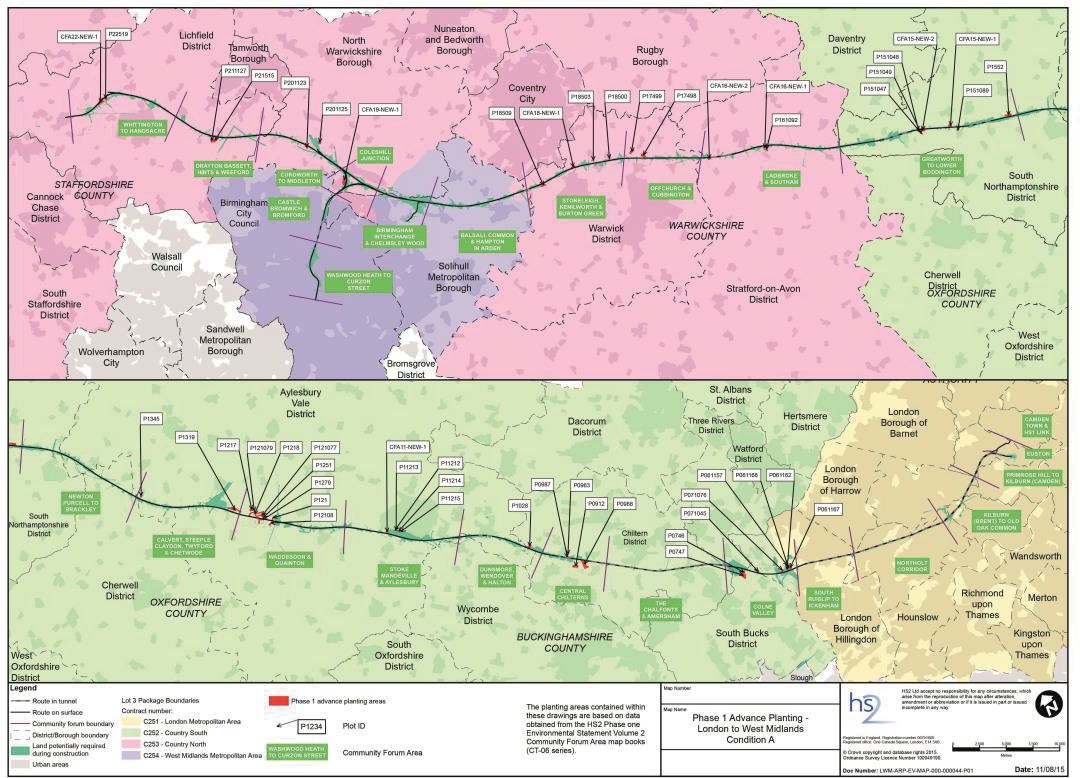
Main Civil engineering works
Due to the nature of the main construction activities, there are only a limited number of locations where planting could take place due to the constraint that this may place on areas required for construction and the likelihood of damage to tree stock.
Railway installation works
Most planting works will occur during this phase and will include planting on completed areas of earthworks, compounds and haul roads.
System testing and commissioning
This final phase involves the commissioning and testing of the railway infrastructure. Planting in this phase will occur on the sites of restored rail installation compounds and haul roads.
Supply of Plant Material Contract
The key to the successful supply, quality and right provenance of the plant stock required throughout the project programme resided in a combination of effective forward planning and realistic lead-in times taking account of growing seasons for horticultural products into the programme. It was felt the most practical form of plant supply would be through a contract growing agreement with a large commercial nursery.
HS2’s Landscape Architect and Procurement teams worked with the HS2 Tree Working Group to plan how best to supply plant material for all phases of the project. Two risks were identified. The availability of plant material of local provenance in enough quantity in time for advanced planting programme and, the limited number of nurseries in the UK available that could provide this volume of plant material production. Planting Specification Workshops were held with attendance Forestry Commission specialists to address these risks.
Setting up the HS2 Supply of Plant Material Contract started in 2015. This posed an ambitious programme that involved an early issue of the Invitation to Tender to ensure commencement of seed sourcing and contract growing of the specified plant material. This was ahead of Phase One gaining Royal Assent. Certain assumptions on seasonality and programme were identified including that seed harvesting be undertaken between August – September 2016 with propagation commencing in 2016. This key assumption was to align with the imminent commencement of the Enabling Works Contract programme in 2017.
The Supply of Plant Material Contract was owned and managed by HS2 Ltd. To help minimise lead-in times it was proposed to specify that transplants be provided as +1 rather than +2 years and/or supplied as containerised material which would potentially provide plant material in time for the commencement of the Enabling Works Contracts. Specifying a certain proportion of container grown stock helped de-risk the pressure on the programme since containerised plant material could be planted outside the dormant season.
Appointing a single, lead nursery addressed the second risk by establishing a single supply point. HS2 Ltd chose to manage the Supply of Plant Material Contract providing control and flexibility across the four construction phases outlined above. It was considered that the lead nursery could form a cooperative of suppliers as well as providing on-going, professional co- ordination for the supply of plant material over the course of the project. This had multiple benefits, including the ability for specialist nurseries to be appointed (under the lead nursery) to provide larger trees (e.g., for urban areas) and specialist species; along with the opportunity to engage smaller local nurseries in specific parts of the route, generating local work, boosting the local economy. Having a lead nursery also offset some of the risk around obtaining seed of the right local provenance for the advanced planting.
At the time of establishing the Supply of Plant Material Contract three key dependencies were identified for the first Advanced Planting works to be delivered successfully they comprised:
- the intention to let an Enabling Works Contract commencing late 2016 that continued post Royal Assent (these contractors would receive plant material and undertake the planting).
- the need to either purchase and or negotiate access to land or for there to be lease agreements to be in place and
- for some land parcels identified for Advanced Planting to have 3rd Party maintenance agreements in place to ensure satisfactory establishment and to define liabilities.
The Supply of Plant Material Contract was based on the NEC3 Short Supply contract (a supply of goods contract). It was adapted by HS2’s legal team to consider aspects of the New Engineering Contract (NEC) Term Service Contracts and Joint Council for Landscape Industries (JCLI) Contract Growing Guidance so it would be both effective and tailormade to HS2’s requirements over its potential ten-year duration. The contract contained a Plant Price Schedule comprising a list of native and near-native tree and shrub species. During tender this was the basis for obtaining rates for each species that would be committed to for periods stipulated in the contract with rate reviews and indexing allowed for.
The contract was awarded to the family-owned business Crowders established in 1798. They have an annual production capacity of 5m units. They source seed, propagate, and manage the supply of plant material for the HS2 project from their base on their 140ha site in Lincolnshire. The contract value over all construction phases is between £5m to £9m.
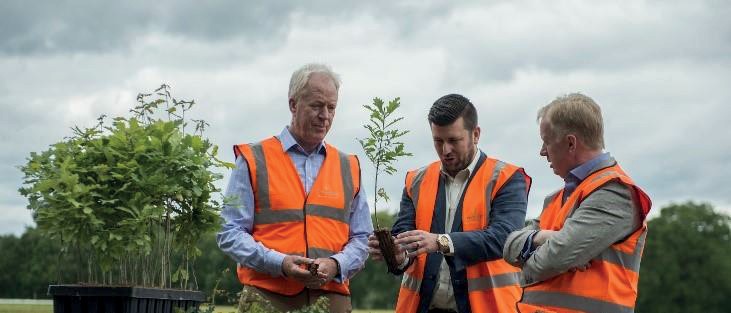
inspect HS2 planting stock.
The supply of plant material order process was also set out in the contract. Crowders have followed this three-stage sequence leading to plant material being available to plant on site. Careful programming and co-ordination between HS2, Crowders and contractors to ensure an ongoing and timely supply of plant material across HS2’s different programmes were important. Seasonal timing is critical in the horticultural industry where account needs to be taken of when seed can be gathered, how long it takes to propagate certain seed species, how much growing time is required to reach the specified maturity through to readiness for supplying plants to site in time for the optimal planting season when plants are dormant.
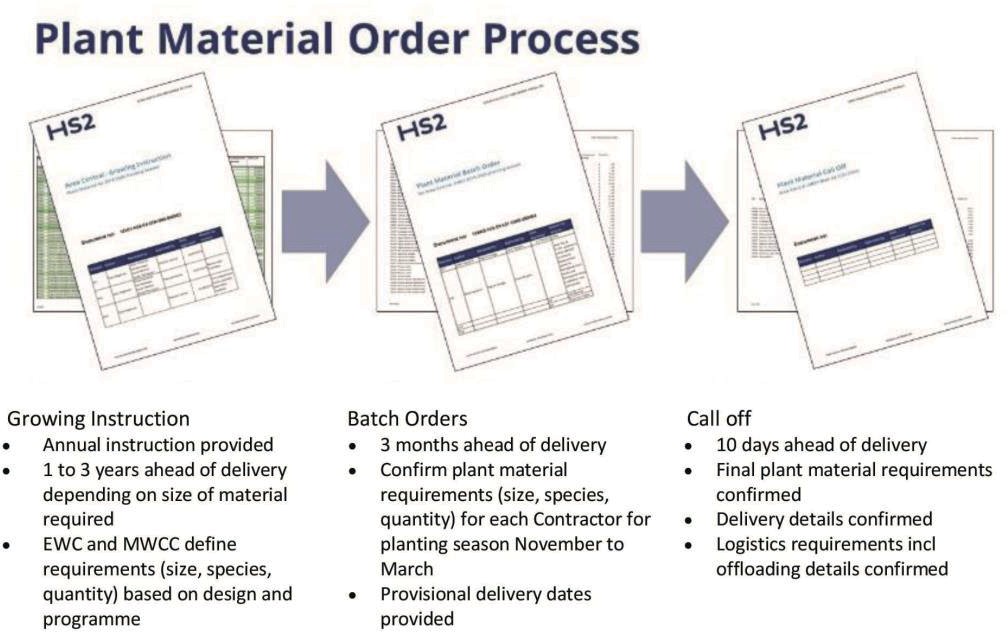
In preparation to ensure plant material in time for commencement of the advanced planting phase in the Enabling Works Contract and, even ahead of the Supply of Plant Material being awarded to Crowders, a crucial first step was for the Landscape Architects to produce a master schedule of shrub and tree planting for all the advance planting sites. This formed the basis of the Annual Growing Instruction shown on the left of Figure 12. The trees and shrubs in this Growing Instruction are then propagated and grown-on at Crowders nursery for between 1-3 years depending on the stock requirements specified by the Enabling or Main Works Contractors.
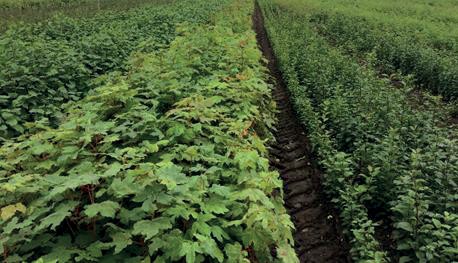
When construction sites are ready to receive plant material a Batch Order is placed as step two in the sequence. Provisional delivery dates are confirmed and ideally targeted to the November – March planting season.
The final Call-Off stage is triggered ten days before delivery to site. The digital plant database set up under the NEC3 supply contract, records and tracks plant numbers, checks specification against the Batch Order and records logistics, delivery and plant handling details which are confirmed between Crowders Nursery and the contractor.
Assets, Data and Planting Procurement
HS2 has a design life of one hundred and twenty years. Design decisions made in the early stage of the project have a considerable bearing on; future maintenance; the realisation of project benefits; fulfilment of environmental commitments and the resilience of all the railway and landscape assets to future change.
As a government sponsored project HS2 is required to design and deliver the project to be Building Information Modelling (BIM) compliant. BIM is underpinned by digital technologies and is a collaborative way of collecting, managing, and sharing project data and asset information during project planning, design, construction and operation.
The scale of HS2 means that a large volume of complex data must be managed, exchanged and interpreted by a range of users and combined with other data sets. BIM enables this. All the data generated by the Plant Procurement Strategy from plant supply, to completed planting locations along with data pertaining to management and maintenance are vital to operating, maintaining, and then sustaining these green assets for the life of the project safely, cost effectively and sustainably.
Selection of plant species is aided by information captured in the early-stage site surveys and held in HS2’s Asset Information Management System (AIMs). The same data assists in the development of Landscape Maintenance, Management and Monitoring Plans, and the implementation of a 50-year management and monitoring programme as part of commitments HS2 Ltd have made in respect of Ancient Woodland compensation measures.
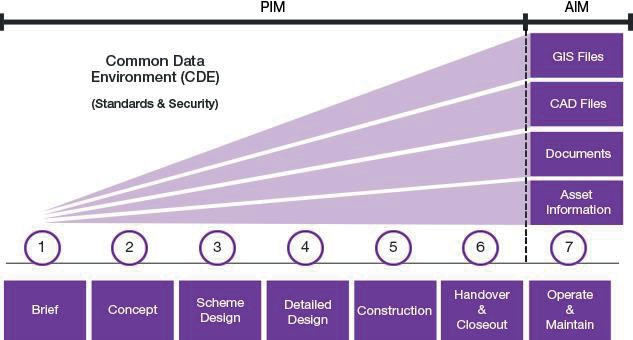
Outcomes
With the major phase of main works construction yet to commence it is too early to evaluate the full and extensive benefits that will arise from the Plant Procurement Strategy, but the following outcomes are of note:
- The results of the Supply of Plant Material contract, providing tailor made plant material of local provenance over nearly four years, is already evident on the ground along the Phase One route. The fruits of the Plant Procurement Strategy can already be seen emerging along the route, establishing, incrementally what will be a one- hundred-and-forty-mile green corridor planned for people ad nature and with resilience to future climate change.
- A significant database has already been collated from the Supply of Plant Material contract which in HS2’s Asset Information Management system is stored alongside existing woodland surveys and proposed woodland creation sites. In a BIM project environment, the volume and maturity of information grows over time until a point is reached where the project is ready for handover to operations and maintenance as a complete, validated and verified Asset Information Model (AIM).
- A positive outcome of the consolidation of relationships with stakeholders, agencies and statutory and non-statutory bodies. This has helped support several community- led planting initiatives already underway along the route.
Learning legacy
Several learning legacy examples can be summarised that stem directly from the Plant Procurement Strategy and are relevant to other large infrastructure projects as well as future phases of the HS2 project:
- The need for ‘whole life’ project planning – Plan early, ensure budgets are secured with satisfactory time in programme to allow for any Project governance processes
- Programme alignment that works for living plant material and seasonal windows with the main construction contract
- Land supply – timely acquisition and control of land across the entire construction and operational programme
- Adopting up to date industry standards and relevant scientific expertise and incorporating these within contract documentation
- CDM (Construction Design and Management) obligations and Health &Safety concerning all stages of design and construction activity. This extends to contract growing of plant material.
- Following best practice Biosecurity standards which are built into the contract and at every stage of the plant selection and handling process
- Effective communication between all parties especially with stakeholders, Tier One contractors and along the supply chain
- Fostering and promoting collaborative behaviours
- Early on boarding of Landscape Architects and adopting a fully inter-disciplinary approach to design alongside Architects, Architects, Engineers, Soil Scientists, Ecologists, and Water specialists
- Never underestimate the importance of robust data acquisition, storage and retrieval that follows BIM, AIMs and HS2 digital engineering standards and protocols
- Design includes future maintenance, management and monitoring requirements and must be in place from the moment plants arrive at site
- Consider the handover of assets i.e., planted areas to next contractor in the programme and what is needed to enable this.
Conclusion
The HS2 Plant Procurement Strategy can be considered whole life project guide to aid design and delivery, to help plan a future, well designed, resilient landscape infrastructure, one that conserves, enhances, restores, and transforms all the various locations and different scales of landscape the railway encounters. At the heart of the Plant Procurement Strategy is a requirement for ‘whole life planning’ so that design decisions made today fully deliver the needs of people and nature in the future.
No new railway has been built in the UK for nearly 120 years. If Sir John Betjeman were able to pass observation on the design and construction of HS2 today, where the design of the landscape was guided by the Plant Procurement Strategy, he might reflect that railway and planted green corridor were in fact ‘carving out’ a future, more contextual landscape in unison, in contrast to time of Victorian railway design and construction.
Acknowledgements References
Peer review
- Charlotte NormanHS2 Ltd
- David GreenHS2 Ltd
- Declan RooneyHS2 Ltd
- Jo RathboneHS2 Ltd


